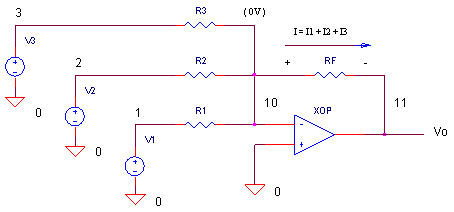Hi,
Everyone says to use Y splitters to divide one signal (output) to multiple inputs, but not the other way round. I've seen passive summing circuits using only resistors, but most circuits use an opamp, with all inputs to be summed going to the inverting input. Here's a typical circuit:

Also, the reason Y adaptors are a bad idea is because each source device sees the parallel combination of the destination's input impedance (should be high), and the other source's output impedance (should be low). Thus, the combined impedance is too low, and the source gets distorted.
My question - in the above circuit, won't each source still see the other sources in parallel with the opamp's input impedance (which is really high, so it doesn't matter). So is it R1 R2 and R3 that are used to make the effective (paralleled) impedance high enough? So in this diagram, I'd probably want to use 100K or so for each resistor... so then each source sees 100K || 50K? And the gain is of course set by the ratio of R1/R2/R3 to Rf. I have other ways to adjust gain (this is to use a single subwoofer for 2-channel as well as 5.1), so all I'm looking for here is the summing action.
One more question - my linestage is a autoformer based passive, so the output impedance at DC is a near short (it's just a long wire). Does that complicate things in any way? If I wanted to sum the left and right channels of my linestage's output (it has 2 sets of outputs), would this cause the other (main) pair of outputs to get shorted and become mono, or something like that?
Thanks in advance.
Saurav
Everyone says to use Y splitters to divide one signal (output) to multiple inputs, but not the other way round. I've seen passive summing circuits using only resistors, but most circuits use an opamp, with all inputs to be summed going to the inverting input. Here's a typical circuit:

Also, the reason Y adaptors are a bad idea is because each source device sees the parallel combination of the destination's input impedance (should be high), and the other source's output impedance (should be low). Thus, the combined impedance is too low, and the source gets distorted.
My question - in the above circuit, won't each source still see the other sources in parallel with the opamp's input impedance (which is really high, so it doesn't matter). So is it R1 R2 and R3 that are used to make the effective (paralleled) impedance high enough? So in this diagram, I'd probably want to use 100K or so for each resistor... so then each source sees 100K || 50K? And the gain is of course set by the ratio of R1/R2/R3 to Rf. I have other ways to adjust gain (this is to use a single subwoofer for 2-channel as well as 5.1), so all I'm looking for here is the summing action.
One more question - my linestage is a autoformer based passive, so the output impedance at DC is a near short (it's just a long wire). Does that complicate things in any way? If I wanted to sum the left and right channels of my linestage's output (it has 2 sets of outputs), would this cause the other (main) pair of outputs to get shorted and become mono, or something like that?
Thanks in advance.
Saurav
summing time and the living is easy
The summing juction is a very low impedance. The inverting input is following the non inverting input voltage by the mechanism of the negative feedback of the op amp.
http://www-s.ti.com/sc/psheets/slod006b/slod006b.pdf
The summing juction is a very low impedance. The inverting input is following the non inverting input voltage by the mechanism of the negative feedback of the op amp.
http://www-s.ti.com/sc/psheets/slod006b/slod006b.pdf
Re: summing time and the living is easy
The opamp keeps the summing point at 0 V wrt to local ground reference.
Inability to do this constitutes distortion at the output terminal.
Eric.
IOW, the summing point is at 'virtual ground'.Fred Dieckmann said:The summing juction is a very low impedance. The inverting input is following the non inverting input voltage by the mechanism of the negative feedback of the op amp.
http://www-s.ti.com/sc/psheets/slod006b/slod006b.pdf
The opamp keeps the summing point at 0 V wrt to local ground reference.
Inability to do this constitutes distortion at the output terminal.
Eric.
Thanks, that's the point that I was missing. Here's a quote from that op-amp article:
I used to know all of this back in college, but it's been a long time since I've had to use any of it
Thanks once again.
Saurav
The opposite end of the resistor connected to the inverting input is held at virtual ground by the feedback; therefore, adding new inputs does not affect the response of the existing inputs.
I used to know all of this back in college, but it's been a long time since I've had to use any of it
Thanks once again.
Saurav
- Status
- This old topic is closed. If you want to reopen this topic, contact a moderator using the "Report Post" button.